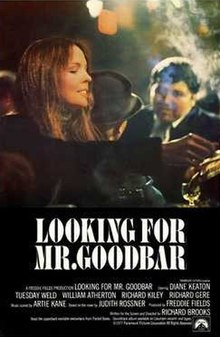Diane Keaton proved her range as a dramatic actress in 1977, the same year in which she made Woody Allen’s romantic comedy, Annie Hall, for which she won the Best Actress Oscar.
That year, she departed from her usual lighthearted comedic roles, earning the highly coveted lead in the psych-erotic drama Looking for Mr. Goodbar.
Grade: B (*** out of *****)
| Looking for Mr. Goodbar | |
|---|---|

Theatrical release poster
|
|
Directed by Richard Brooks, the film stars, in addition to Keaton, Tuesday Weld, Richard Kiley, and Richard Gere, all in top form.
The film is based on the novel of the same name by Judith Rossner, which was in turn based on the real-life murder of New York City schoolteacher Roseann Quinn.
As a morality cautionary tale, it traces the sexual awakening of a young teacher searching for excitement outside of her mundane existence.
Keaton plays Theresa Dunn, a Catholic schoolteacher for deaf children, who lives a double life, spending her nights at singles bars, engaging in promiscuous (one-night stands) sex. Keaton perceived the part as a “psychological case history.”
After an affair with her college professor, no-longer-good Catholic girl Theresa follows the lead of her hedonistic sister (Tuesday Weld, perfectly cast), and moves out of her oppressive family home to forge a life of her own.
Searching for the “real perfect man,” whom she refers to as “Mr. Goodbar,” she begins losing control of her life as her sexual appetite grows.
A quiet and reserved teacher by day, sexual deviant and bar-hopper by night, Dunn begins to dabble in drugs and the company of unstable men. Her self-destructive behavior is a means of escaping her numbing existence and testing her boundaries, providing excitement in her otherwise safe and boring life.
Dunn prefers the satisfying attentions of unpredictable, danger-tinged stud Tony Lopanto (Richard Gere) to the more noble intentions of social worker James (William Atherton). She ditches anyone who prevents her from being her “own girl.”
As her sexual partner, Tony is a borderline psychotic, who turns jealously possessive, beginning to threaten her life. Ultimately, her sexual addiction and high-risk behavior put her life in real danger.
Tuesday Weld received a nomination for Best Supporting Actress Oscar (her first and only nod) for her performance in the film.
The music video for the Madonna song, “Bad Girl,” was loosely inspired by the film.
Keaton deserved an Oscar nomination for playing compellingly a woman who’s a compassionate teacher of deaf children by day, and metamorphoses into a sexually free cruiser of singles bars by night. But in the same year, she scored even better in Woody Allen’s comedy, Annie Hall, for which she received the Best Actress Oscar.
Time magazine commended her role choice and criticized the restricted parts available for female actors in American films: A male actor can fly a plane, fight a war, shoot a badman, pull off a sting, impersonate a big cheese in business or politics. Men are presumed to be interesting. A female can play a wife, play a whore, get pregnant, lose her baby, and, um, let’s see. Women are presumed to be dull. … Now a determined trend spotter can point to a handful of new films whose makers think that women can bear the dramatic weight of a production alone, or virtually so. Then there is Diane Keaton in Looking for Mr. Goodbar. As Theresa Dunn, Keaton dominates this raunchy, risky, violent dramatization of Judith Rossner’s 1975 novel.”
The film became nearly prophetic in the early 1980s in the wake of the lethal AIDS crisis.
Commercial Hit
Made on a small budget of $2.5 million, the movie was a commercial hit, earning $22.5 million at the box-office.
Oscar Nominations: 2
Supporting Actress: Tuesday Weld
Cinematography: William A. Fraker
Oscar Awards: None
Oscar Context:
The winner of the Best Supporting Actress Oscar was Vanessa Redgrave for Julia.
Vilmos Zsigmond won the Cinematography Award for Spielberg’s sci-fi blockbuster, Close Encounters of the Third Kind.
Cast
Diane Keaton as Theresa Dunn
Tuesday Weld as Katherine Dunn
William Atherton as James
Richard Kiley as Mr. Dunn
Richard Gere as Tony
Alan Feinstein as Martin
Tom Berenger as Gary
Priscilla Pointer as Mrs. Dunn
Laurie Prange as Brigid
Alexander Courtney as Arthur
Joel Fabiani as Barney
Julius Harris as Black Cat
Richard Bright as George
LeVar Burton as Cap Jackson
Brian Dennehy as Surgeon
Richard Venture as Doctor
Elizabeth Cheshire as Young Theresa
Credits:
Directed by Richard Brooks
Screenplay by Brooks, based on the novel “Looking for Mr. Goodbar” by Judith Rossner
Produced by Freddie Fields
Cinematography William A. Fraker
Edited by George Grenville
Music by Artie Kane
Distributed by Paramount
Release date: October 19, 1977
Running time: 136 minutes
Budget $2.5 million
Box office $22.5 million










